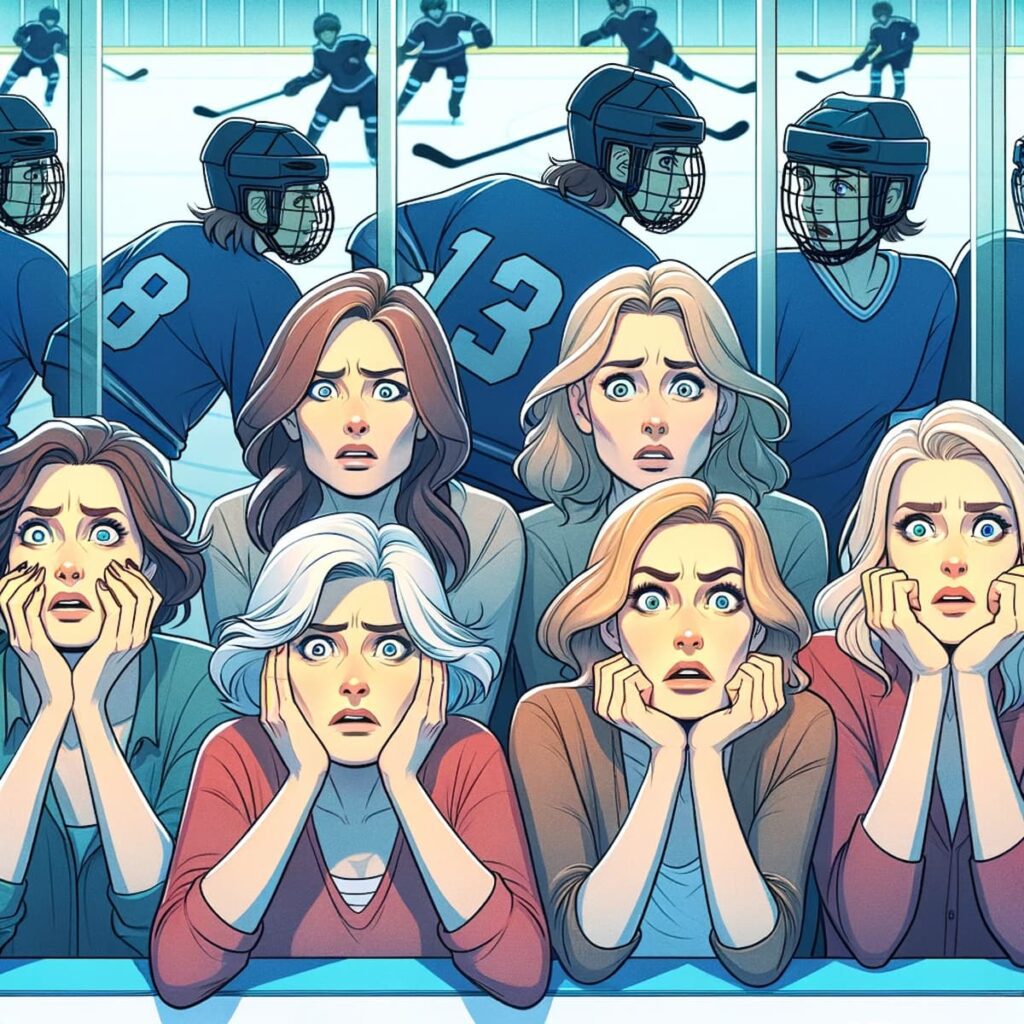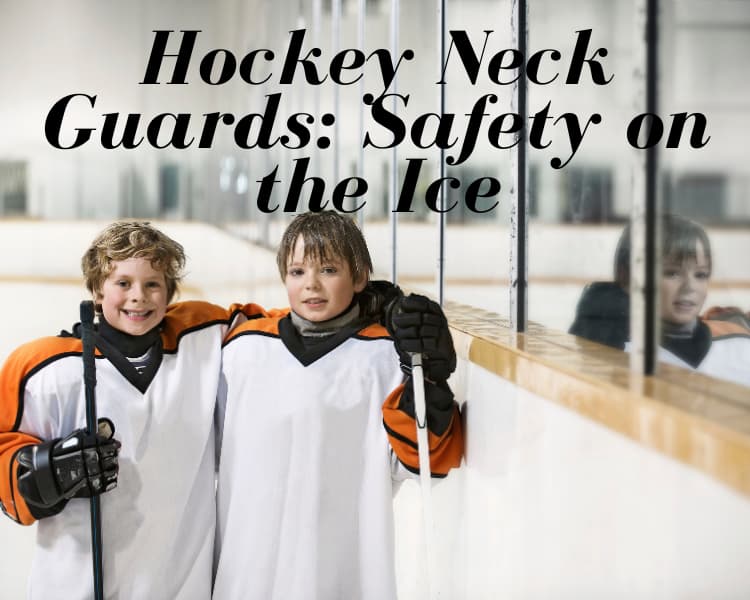Hockey Neck Guards: Ensuring Your Child’s Safety on the Ice
Updated on February 4, 2024
In this article, we explore the critical importance of hockey neck guards in ensuring player safety on the ice. From understanding the inherent risks to choosing the right fit, our comprehensive guide dives deep into expert recommendations, research findings, and real-world parent reviews. Keep your young athlete’s neck area protected and elevate your peace of mind.
The Hockey Neck Guard can be a struggle when it is still not required by USA Hockey. It is highly recommended. And now with the passing of a young teen in Connecticut in January of 2022 and for NHL player, Adam Johnson, this may be a requirement soon, as it is in England.
It’s a moment we’ve all dreaded—a collision, a tumble, and then silence on the ice. Your heart stops, only to restart when you see your child get up and skate away. Whew! Crisis averted, but it could have been worse. This game we love keeps us on the edge of our seats for more reasons than just the score. Parents, let’s talk about something vital but often overlooked: hockey neckguards.
Hockey Neck Guards: Understanding the Risks Without Them
Ice hockey is exhilarating but also fraught with perils, particularly when it comes to injuries. Did you know that according to a study by the Journal of Athletic Training, neck injuries account for nearly 4% of all ice hockey-related injuries? Although it may sound small, remember that the neck is a sensitive area where veins, arteries, and nerves are dangerously exposed. So whether your child dreams of being the next Wayne Gretzky or is just playing for the love of the game, it’s crucial to minimize risks.

I’ll never forget the poignant moment in January of 2022 when we placed our hockey sticks outside to pay tribute to a young, promising life cut short in a devastating accident on the ice, involving a skate blade. May we never have to place our sticks out for such a heartbreaking reason ever again.
USA Hockey’s Strong Recommendation
USA Hockey had always “recommended” neck guards, but as of January 28, 2024, it was signed into the Rule book (effective August 2024) to reflect USA Hockey Congress signed neck laceration guards as a requirement to play hockey if under the age of 18. This legislation also extended to any referees under the age of 18.
USA Hockey, the guardian angel of ice hockey in the United States, says, “We had always recommended the use of neck laceration protectors for all amateur hockey players.” These recommendations have been elevated to requirement in the wake of tragic incidents involving neck lacerations, like the case of young Adam Johnson.

USA Hockey advocates for all athletes to use neck guards designed to offer extensive neck coverage. Ongoing studies and enhanced criteria assessments will further clarify the efficiency of these protective devices in preventing neck lacerations
Different Styles and Options
Parents, take note: not all neck guards are created equal. Your shopping list should include:
- Cut-resistance levels.
- Full neck coverage.
- Comfort and fit
You want something that your child can wear comfortably, yet provides maximum protection if every involved in potential catastrophic involvement of arteries.
Per USA Hockey, the Neck laceration protectors with Spectra fibers were the most cut resistant.
When it comes to safeguarding your child’s neck on the ice, you’ve got options—each with its own pros and cons. It’s like choosing between a slapshot and a wrist shot; both can score, but you gotta know when to use them. Let’s break down the three main types of neck guards available: the classic wraparound, the bib style, and the integrated compression layer neck guards.
Classic Wraparound Neck Guards
The traditional neck guard is a simple piece that wraps snugly around the neck. Usually made from cut-resistant materials like Kevlar, they’re the minimalist choice. They’re great for players who don’t want too much bulk, but beware, they provide the least amount of coverage. Think of these as the forwards on your protection team—fast, efficient, but not the ones you’d use to guard the net in a crunch.
Pros:
- Lightweight
- Less restrictive
Cons:
- Limited coverage
- May not be sufficient for hockey goalies or more aggressive play styles
Bib Style Neck Guards
Imagine a knight’s armor, but for your aspiring NHL star. This type comes with an additional ‘bib’ that covers the upper chest and back area. It’s a step up in protection, offering an extended zone of safety. These are your defensemen—solid, dependable, and they’ve got more of the ice covered.
Pros:
- Extended coverage for chest and back
- Additional protection from pucks, sticks, and skates
Cons:
- More bulky
- May be warmer, leading to more perspiration
Integrated Compression Layer Neck Guards
The future has arrived, folks! These are neck guards woven right into a compression layer top. The top fits like a second skin and has the neck guard built right into it. It’s like having your cake and eating it too, or in hockey terms, scoring a goal and getting the assist.
Pros:
- All-in-one solution
- Improved comfort and fit, less fidgeting from players
- Provides consistent protection as it stays in place
Cons:
- More expensive
- If the shirt gets damaged, the whole unit may need to be replaced
- Limited options for adjustments in neck size or fit
So, hockey parents, the takeaway here is to weigh your options carefully. Consider your child’s position, playing style, and comfort level when making this all-important decision – and whatever they will least fight you on wearing until the day when finally the neck guard is required for play.
Whatever choice you make, just remember: the ultimate aim is to enjoy this incredible sport while keeping our young athletes as safe as possible. Let’s keep the game going and keep our kids protected!
Research Findings
For the data-hungry among us, a study conducted by Loyd et al. in 2015 offers some eye-opening insights. Their findings indicate that the cut-resistance levels between different neck guards can vary drastically. Shockingly, some even failed at high-force levels. You can read the full study here for all the nitty-gritty details. In layman’s terms? Do your homework before you buy. Don’t forget coverage, comfort, and failure rates when independently tested.

In the end, Loyd et al found that high-force tests when neck guards failed:
“showed that the majority of neck guards failed at 600 N and 45-degree angle tests. Of 14 neck guards tested, 11 failed; of 3 neck guards that did not fail, 2 were of the Skate Armor brand (0/2), and 1 was a Reebok 11K (1/3) (Table 2). All neck guards sustained device injury for each of the high-force tests.” (1)
Choosing the Best Neck Guards
When it comes to brands, names like Nike Bauer, CCM, and Easton are top-of-the-line in neck guard tech. As one parent humorously reviewed, “It’s like a fortress around my kid’s neck!” On the flip side, watch out for shrinking neck protector. A snug fit today could be a chokehold tomorrow, reducing its protective capability.
Avoid placing these in the dryer due to shrinkage! You want as much neck protection and coverage as possible.
Ah, the moment of truth—choosing the neck guard that’ll be your child’s frontline defense on the ice. Not to worry, though! I’ve got a game plan that will make even a seasoned coach nod in approval. Here are some tried-and-true tips for selecting the best neck guard for your rising hockey star:
1. Know Your Child’s Playing Style

Is your kiddo a fearless forward, always in the thick of the action? Or perhaps a stalwart defenseman, ready to put their body on the line? Each playing position and style may require different levels of protection. For example, defensemen and goalies might benefit more from bib-style neck guards for the extra coverage they offer.
2. Size it Right
Choosing the right size is like landing a perfect slapshot—it’s essential! A neck guard that’s too tight may restrict movement and be uncomfortable, whereas a loose one may not provide adequate protection. Measure your child’s neck circumference and consult sizing charts to find the perfect fit.
3. Material Matters
When it comes to material, think cut-resistant but breathable. Look for neck guards made from ballistic nylon, Kevlar, or similar materials that offer both comfort and protection.
4. Check for Certifications
Always go for certified neck guards. For players in the United States, check if the product is compliant with USA Hockey or ASTM (American Society for Testing and Materials) standards. This ensures that the product has undergone rigorous testing and meets safety benchmarks.
You may see some hockey gear that is Canadian or European certified such as: “CE and BNQ Certified” for must-have cut protection against sharp skate runners.
5. Do the ‘Wear Test’
If possible, have your child try on the neck guard with all their other gear. They should be able to move freely and comfortably. It’s a good idea to also check how the guard fits while they are in a skating posture.
6. Read Reviews and Get Recommendations
While you may not be able to gather around the rink’s bleachers for advice right now, online parent forums and reviews are a gold mine of information. Find out what other parents—and more importantly, other kids—like or dislike about different neck guards.
7. Budget but Don’t Skimp
We all want to save a buck where we can, but safety is not the place to cut corners. While pricier doesn’t always mean better, make sure you’re not sacrificing quality for a few saved dollars.
8. Replace as Needed
Remember, neck guards aren’t a ‘one-and-done’ purchase. Inspect them regularly for wear and tear, and be ready to replace them as needed or as your child grows.
In summary, picking a neck guard is like selecting a linemate; you want reliability, strength, and a good fit. Doing your research and sizing correctly can go a long way in ensuring your child’s safety on the ice. And who knows, with the right gear and peace of mind, you might just be watching a future NHL star in the making!
Conclusion
Hockey parents, we’re all in this together. Yes, the game comes with risks, but it also brings joy, camaraderie, and valuable life lessons. Let’s make the arena a safer place for everyone. After all, the ultimate goal isn’t just winning; it’s playing the game we love safely. Your child’s safety is a team effort, so let’s keep the puck rolling—in the right direction.
The aim is to foster a strong sense of community and support among ice hockey parents because after all, we’re all on the same team when it comes to keeping our kids safe!
References:



